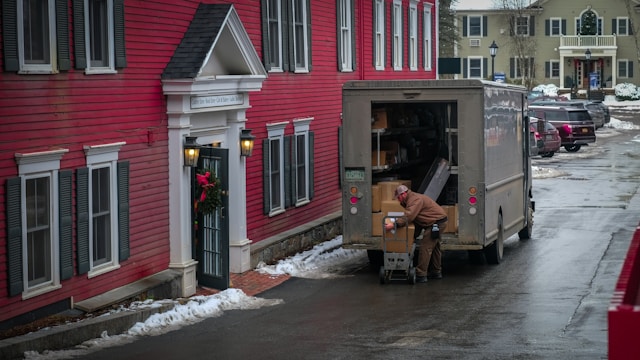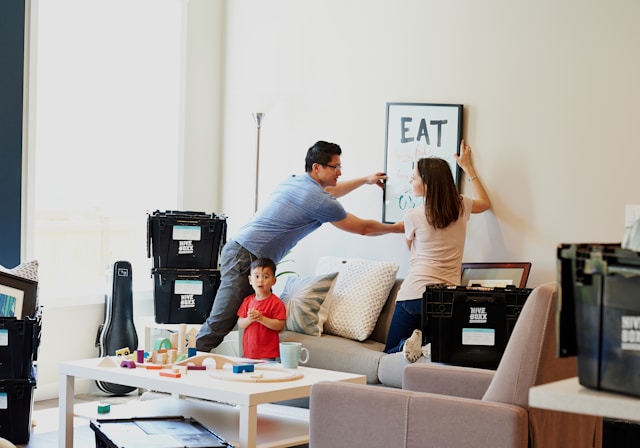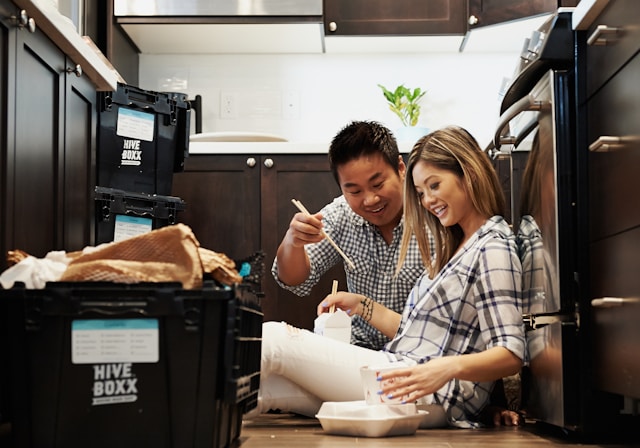The Ultimate Moving Guide

Planning a move? You’re in the right place. National Storage is here to help you, whether you’re moving away from home for the first time, relocating across town, or starting a new adventure in a brand-new city, this guide is packed with everything you need to make your move smooth and stress-free. From the very first step of prepping your current home to unpacking the final box in your new space, we’ve got all the moving tips and strategies you’ll need along the way.In this comprehensive guide, we’ll walk you through what to do before moving into a new home, how to declutter and downsize your belongings, and how to pack like a pro. You’ll also find practical advice on the best tips for packing and moving, clever packing tips for moving out of home, and smart strategies for staying organized throughout the whole process. Let’s get started on making your move the best one yet!
Moving Supplies Checklist
Before you even tape up your first box, having the right tools on hand will make all the difference. A solid supply kit not only saves time but can also prevent a lot of unnecessary stress. The goal here is to stay organized and avoid last-minute trips to the store—because nobody wants to stop mid-pack to hunt down a roll of tape.
Start with boxes. You’ll want a good mix of sizes to accommodate different items throughout your home. Use small boxes for heavier things like books and larger ones for lighter, bulkier items like linens. Packing tape is your next must-have—look for a heavy-duty option that seals well and won’t peel up easily. A sharp pair of scissors or a utility knife makes cutting through tape and cardboard smooth and hassle-free.
You’ll also want to keep a few permanent markers nearby to label everything clearly—knowing what’s inside each box (and where it goes) will be a game changer when you’re unpacking. Don’t overlook the usefulness of things like plastic bags for storing small items or non-perishables, and moving blankets or towels to cushion fragile pieces. For extra protection, grab some bubble wrap or old newspaper, especially for kitchenware and décor. And if you’ve got heavy lifting to do, a handcart or dolly can help prevent back strain and speed things up.
Here’s a quick bullet point recap of the essential moving supplies you’ll want to gather before packing:
- Assorted moving boxes – Small, medium, and large sizes for different household items
- Packing tape – Strong and durable for sealing boxes securely
- Utility knife or scissors – Ideal for cutting tape, cardboard, and more
- Permanent markers – To clearly label each box by room and contents
- Plastic bags – Useful for grouping small items and storing pantry goods
- Blankets or moving pads – For protecting fragile furniture and mirrors
- Bubble wrap or newspaper – Added cushioning for dishes and glassware
- Handcart or dolly – To move heavy boxes and furniture safely and efficiently
How to Declutter Your Home Before Moving
Decluttering Methods
Moving away from home, or moving to a new home is the perfect excuse to declutter and be ruthless about the stuff that deserves to make the cut and be worthy of your new home. After all, why haul things you no longer use or need to your new space? One of the best tips for decluttering is the 2:2 rule. With the 2:2 rule, you ask yourself “have I used this item in the last two years? Will I use it in the last two months?” If it’s a no in both categories, it’s probably time to let it go. This step is especially helpful when moving away from home for the first time and realizing you don’t need that high school debate trophy anymore.
Another way to help you declutter, according to Marie Kondo and the KonMari Method, is to decide if the items you’re evaluating “spark joy.” If certain belongings no longer serve any purpose, or don’t elicit a positive response of joy, it’s a good sign that you can live without the item.
There are also two ways to go about what to start decluttering. Most people choose to go room to room. You can also do it by category, i.e. clothes, books, papers, etc. This way, you can tackle multiple rooms at once. There isn’t a correct way to do it, but whatever makes the most sense for your situation.
Be strategic and try the four-box method: one for keep, one for donate, one for trash, and one for unsure. That last box will be useful for items you’re on the fence about. Revisit it a week later with a clear mind—you might find it easier to let things go. Decluttering not only reduces the number of boxes you’ll need but also helps you feel mentally lighter about your move.

When to Start Decluttering
Begin the decluttering process early—ideally, at least a month before your move. Start with less frequently used areas like the attic, garage, or storage closets. These spots tend to accumulate things you’ve forgotten about, and clearing them out will give you a great sense of accomplishment. Donate gently used items, recycle what you can, and toss anything that’s broken or no longer functional.And remember, you’re not in this alone. Get the family involved or ask friends to help you sort through things. Decluttering can be an emotional process, especially when memories are tied to belongings. Having someone with you can make those tough decisions a little easier.
How to Start Packing for a Move
There’s a lot to unpack here (pun intended). Starting to pack your home up probably feels daunting. In fairness, it is a huge task. So how do you start packing for a move? Begin with a plan. Choose a moving day, count backward, and create a packing schedule. When it comes to actually start parking, begin with rooms you use the least – think guest rooms, storage spaces, or formal dining areas and leave the areas you frequent most for last (bedroom, bathroom, kitchen, etc.)Set realistic daily or weekly goals. For example, aim to pack one room each week. This helps spread the workload and keeps the process from feeling overwhelming. Be sure to gather all your packing supplies before diving in.

How Many Boxes Will You Need?
A question as old as time… If you’re not sure how many boxes you’ll need for a move, here’s a general guide based on the size of your home:
For homes between 400–700 square feet:
- 7 to 15 small boxes or 9 to 15 medium boxes
- Plus 6 large boxes or 3 extra-large boxes
For homes between 700–1,250 square feet:
- 7 to 23 small boxes or 15 to 22 medium boxes
- Plus 7 to 11 large boxes or 4 to 6 extra-large boxes
For homes between 1,200–2,000 square feet:
- 32 to 40 small boxes or 25 to 45 medium boxes
- Plus 16 to 26 large boxes or 10 to 13 extra-large boxes
This should give you a solid starting point as you prepare for your move.
Best Tips for Packing and Moving
Before you get started packing and moving, a handy tip is to create a moving folder. Essentially, this is a hard-copy folder where you collect all information regarding your move including new address info, rental information, contracts with moving companies, rental agreements and the like. This allows you to keep organized and have everything in one central place.

The Russian Doll Technique
Ok, let’s talk about actual packing methods. The question of how to pack for a move comes up in nearly every moving-related conversation. It’s one thing to box up a few things; it’s another to do it efficiently so that unpacking is easy. One smart technique to consider is the “Russian Doll” approach to packing. It is exactly what you’re thinking – those nesting dolls that get smaller and smaller as you open each one up. When applied to packing, this method involves placing smaller, packed containers or boxes inside larger ones to save space and keep similar items together.This technique is especially handy when packing up those miscellaneous odds and ends – think desk supplies, kitchen utensils, or small decor items. By grouping similar small items into smaller boxes or containers first, and then placing them inside a larger moving box, you create a neat and compact system that keeps everything organized.It’s one of the best packing tips for moving, especially when you’re short on space or trying to stay on top of clutter. Plus, unpacking is way easier when you can find all your smaller items grouped together in one spot instead of scattered across multiple boxes.
Label Everything
One packing tip that may feel tedious, but will save you so much headache in the long run is overlabeling your boxes. This means make a list of everything you pack in each box, especially items you’ll want to unpack right away. This helps you find things quickly without opening every box and digging around. Write the contents on the top and at least two sides of the box. That way, you can still read the label even if the box is stacked or tucked behind others.It’s also not a bad idea to come up with acronyms or shorthand for some of your naming conventions, especially if you are using a moving company. You don’t want to label a box “my expensive jewelry” if someone else is handling your stuff. And if you’re worried about losing track of your naming conventions, you can keep that in your moving folder. See, we told you it would come in handy!
Packing and Moving Furniture
In the same vein, lets talk about packing and moving furniture. Furniture can be some of the most challenging and time-consuming items to pack and move, especially when disassembly is involved. There’s a great chance that whatever assembly documentation you once had has been thrown away. So, when it comes to helping your future self reassemble furniture, a smart approach is to document the disassembly process as you go—snap photos or even record short videos of how everything comes apart. Focus on the hardware and unique features that might confuse you later. It might seem unnecessary at the moment, but you’ll be glad you did when it’s time to put it all back together.As you remove screws, bolts, and other small pieces, store them in clearly labeled bags. Write the name of the furniture item directly on the bag and, if you’re feeling extra organized, jot down the number of pieces and where they go. This kind of detail will prevent a lot of head-scratching during reassembly.Wrap individual furniture components in moving blankets or bubble wrap to avoid scratches and dings. Use stretch wrap or tape to secure drawers and doors shut so they don’t swing open in transit. And always load heavier pieces on the bottom when stacking in a truck or storage unit.

Packing and Moving Clothing
Clothing might seem like the easiest part of the move, but if you’re not careful, it can quickly become a wrinkled mess—or take up more space than it should. It’s tempting to toss everything into a box or a trash bag and call it good, but a little extra effort here goes a long way in making unpacking more manageable.Compression bags are awesome for bulky items like ski gear, winter jackets and anything puffy or bulky. Just make sure the clothing is clean and dry before sealing it up. When it comes to your everyday clothes, rolling instead of folding is a smart trick. Not only does it save space, but it also helps reduce wrinkles. Don’t forget to separate out a small bag or suitcase of clothes you’ll need immediately after your move. Include essentials like a couple of changes of clothes, pajamas, and anything work- or weather-related. That way, you won’t be digging through boxes on your first night in your new home.
Packing and Moving Pictures and Photo Albums
Your photos are some of your most important memories. That’s why it’s important to store them the right way. Learning how to pack photo frames and pictures properly can help keep them safe. Use these tips to protect your memories and keep them in great shape for years to come.First, you’ll want to organize your photos and decide which to keep, which to throw away and which you should digitize. Next, use empty or partially filled photo albums or scrapbooks to store loose photos. Choose album pages that are acid-free and lignin-free to help keep your pictures safe over time.Take photos out of their frames to avoid damage from broken glass. Wrap each frame in bubble wrap to protect it, especially if it might get stacked under heavier items.
How to Properly Pack and Unload a Moving Truck
If you’re planning to handle your move yourself, it’s helpful to know how to load and unload a moving truck the right way. Once your home is packed up and you’ve got help lined up, you’ll want moving day to go as smoothly as possible. A little planning ahead can make a big difference.When loading a moving truck, start by gathering all the necessary supplies—like a dolly, furniture pads, tarps, and bungee cords—to make the process easier and safer. Begin with your heaviest items, such as large appliances, placing them upright against the cab wall. Next, load bulky furniture like mattresses and sofas upright along the longest wall, using covers to protect them. Distribute the weight of your belongings evenly throughout the truck to avoid overloading and extra fuel costs. Finish by filling in the open spaces with boxes, placing heavier ones on the bottom and lighter ones on top. Use soft items like bedding and pillows to cushion gaps and keep everything secure.Before unloading your moving truck, take a few minutes to walk through your new home and make sure there’s enough space to move large items through hallways and doorways. Show your helpers around so everyone knows where things belong. Create a safe, clear path from the truck to the front door and throughout the home, laying down plastic in high-traffic areas to protect the floors. As items come off the truck, place boxes directly into their designated rooms—clear labeling makes this much easier—and take inventory to ensure everything arrived safely. Once everything is unloaded, start setting up larger pieces like furniture and appliances, but keep in mind that fully unpacking will likely take more than one day.It’s not uncommon to realize that certain things may not immediately have a place in your new home. In the interim, a storage unit is a great way to keep your belongings safe while you get settled into your new home.
Packing and Unpacking a Storage Unit
We’ve mostly been talking about packing and moving a home. But you may need short-term self storage to help give you more time and space for your move. Short-term storage gives you a safe, convenient spot to keep your belongings while you get everything else sorted out. To make the most of your storage space, create aisles for easy access and stack items vertically—placing heavier pieces on the bottom. Choosing the right vehicle is also key: pickup trucks work for smaller loads, while box trucks and cargo trailers are better for larger moves. Finally, make your items more manageable by disassembling furniture and using vacuum-sealed bags. These steps will save space, make loading and unloading easier, and help keep everything in good condition.For more moving tips, use our Ultimate Self Storage Guide. It’s a great resource that walks you through everything you need to know about storage – like how to pick the right unit size, what features to look for, and more.

Avoiding Common Moving Mistakes
Avoid common packing mistakes by learning from others. This article on top moving and packing mistakes offers some great insight into what not to do. For instance, you don’t want to use the wrong packing materials for your move. That can lead to broken or damaged belongings. A major common mistake is waiting till the last minute to start packing. Procrastination leads to chaos, and that’s the last thing you want during a move. You end up losing things, things get broken – it makes an already stressful situation worse. Give yourself ample time to move.Finally, if you’re moving with kids, this blog on helping children prepare for a move is an amazing resource. A move can be a big change for little ones, and helping them feel involved and informed can make all the difference.
What to Do Before Moving Into a New Home
To this point, we’ve mostly covered how to pack and prepare your home for a move. Here we’ll cover more of the planning, coordination and the little details you probably aren’t thinking about when it comes to actually moving into a new home.
Prep 6-8 Weeks Before Move
As we mentioned above, waiting till the last minute is one of the worst things you can do for your mental wellbeing when it comes to moving. Give yourself a lot of time to prepare for your move. You should really start planning up to two months, or eight weeks before you move. During that time, here’s what you’ll want to do:
Create a Moving Checklist
Be sure to list everything that needs to be done before, and after, your move. Include in this list what needs to be moved and what needs to go to storage. Also, list what items are to be handled by you and what is to be handled by the mover. At this time, also decide what you do not need and dispose of it or consider a garage sale if time allows.
Decide on a Moving Company or Rental Truck
You’ll want to decide if you need to get a moving truck or hire a moving company. There are pros and cons to each. For instance, renting a moving truck and doing it yourself is more affordable, but moving heavy items like appliances and furniture is not only not very fun, but can be unsafe depending on the item. That’s where hiring a moving company can be worth every penny. Once a decision is made, discuss ALL costs involved, packing, timing and other necessary details. Also, many moving expenses are tax deductible so keep a file with receipts and any other important information. Again, this is a great item to keep in your moving folder.
Other Preparations
- Contact your local Chamber of Commerce to find information on schools, parks, community programs, libraries, etc. Locate hospital, fire department, police station, post office, veterinarian, doctor, dentist, etc.
- Gather important information such as: Medical records, prescriptions, vaccination records, veterinary records, and insurance documents and keep them in a safe place.
- Go to your post office and pickup a free Moving Information Packet: This will include the “Change of Address Form” along with who to contact with your new address and information (utilities, trash company, water, internet provider, insurance companies, cable/satellite company, banks, etc.) It also contains other useful information as well as coupons for you to use.

Things to do 1 Week Before You Move
Almost there. Time to start buttoning up everything. If you opted to use a moving company for your move, this first step is particularly important:
Coordinating with the Moving Company
Before moving day, double-check that your moving company has the correct address and phone number for your new home. It’s also a good idea to provide them with an alternate contact number, just in case they need to reach you and your main line isn’t available. If possible, give them a temporary phone number and address where you can be reached until you officially arrive at your new home.
Labeling and Prepping for the Move
We promise this is one of the best packing tips for moving out of the home: Label your boxes clearly and thoroughly. Use terms like “fragile,” “this side up,” “do not tip,” and “load first” to help ensure your items are handled correctly. Write on multiple sides of the boxes and include a short list of what’s inside to make unpacking easier, as we mentioned above.At least one day before moving, empty, defrost, and clean your refrigerator. If you have a safety deposit box, stop by your bank and empty it out. Back up important files on your computer, then carefully disassemble and pack it. Store the components in a box labeled “computer,” and try to avoid exposing it to extreme temperatures during the move.Prepare a “first night” box with essentials you’ll need right away once you arrive. Include snacks, water, disposable plates and cups, paper towels, toilet paper, trash bags, tape, a flashlight, batteries, your phone and charger, and maybe a small rug or carpet protector to keep your new floors clean while unloading.Also, make alternate plans in case there are delays. Keep necessary items with you instead of in the moving truck, and confirm your travel arrangements in advance.
Moving Day
Before the movers arrive, check every area of your home—closets, drawers, shelves, attic, garage—to ensure nothing is left behind. Stay present throughout the loading process to oversee what gets packed and to answer any questions. Once everything is loaded, do a final walkthrough and inspect the entire home.Before leaving, turn off all lights and appliances, and lock all windows and doors. It helps to appoint someone to direct the movers and answer questions. Make sure the driver has your contact information in writing, including your name and phone number. Also, take note of the destination agent’s name, address, and confirmation number. There’s a chance you may arrive at your new home before the moving truck, so plan accordingly and be patient.Before they leave, sign the bill of lading and confirm all your details are correct.
Move-In Day and Beyond
As your items are unloaded at your new home, inspect everything for any signs of damage or missing items. Check that all utilities—electricity, water, gas, and internet—are working as expected. Start planning where you want to place your major furniture and appliances to make the unpacking process smoother.It’s also smart to carry traveler’s checks or some cash for any immediate expenses. Finally, don’t forget to update your driver’s license and any other legal documents if you’ve moved to a new state.
Move Like a Pro
We at National Storage know that moving to a new home is a major milestone – whether you’re moving away from home for the first time or just relocating across town. With a bit of planning and a few solid strategies, the process doesn’t have to be overwhelming. Use this guide as your go-to resource for packing tips for moving, organizing your timeline, and making smart decisions along the way. The adventure awaits—and with these moving tips in your back pocket, you’re well on your way to a smooth, successful transition! And if you need a reliable storage unit for that move, National Storage is here to help!
 (2000 x 418 px)_12162025071120596.png)
